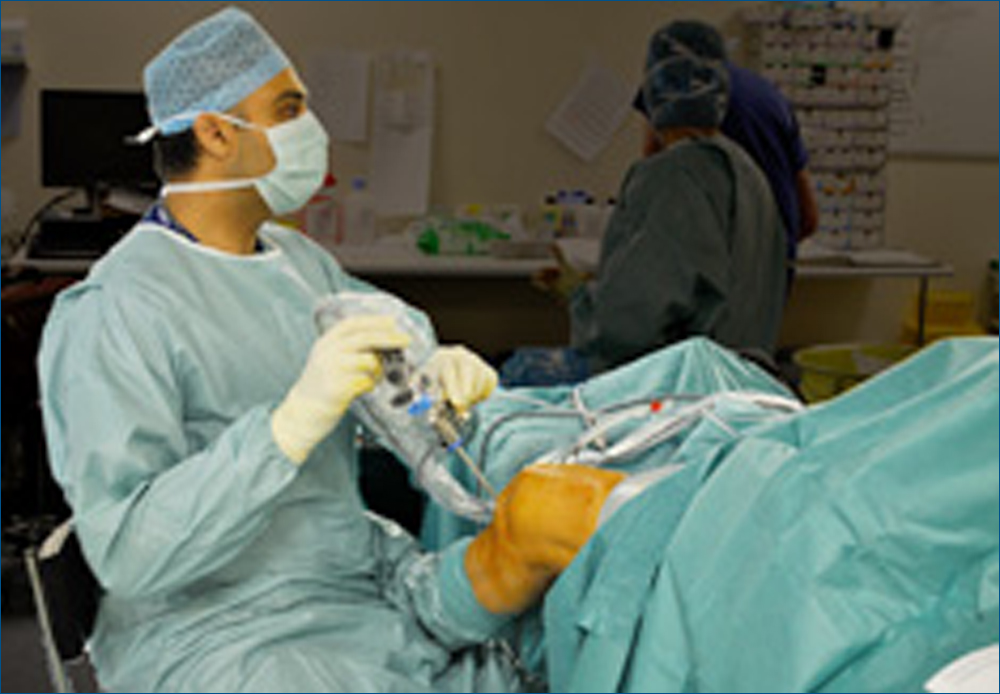The two main forms of arthritis affecting the hip are osteoarthritis (OA) and rheumatoid arthritis (RA).
Rheumatoid Arthritis is a condition of unknown cause where the lining membrane (the synovium) of joints becomes inflamed. Damage to the joint surfaces follows, resulting in the destruction of the lining cartilage; the joint becomes painful and arthritic. Many joints can be involved, especially those in the hands and feet, but the larger joints such as the hip and knee are also commonly affected.
Osteoarthritis is by far the most common form of arthritis. It is estimated that 25% of females and 16% of males over the age of 60 are symptomatic from osteoarthritis. Over 55,000 hip replacements are performed in the UK each year to treat osteoarthritis. This page concentrates on osteoarthritis.
OA is a degenerative disorder in which there is progressive loss of articular (surface) cartilage accompanied by new bone formation and capsular fibrosis (stiffening). In effect, this is ‘wear and tear’ arthritis. Many joints can be affected or just one.
There are 2 basic types of osteoarthritis; primary and secondary:
There is no obvious cause of primary osteoarthritis; causes of secondary OA include:
Previous trauma (fracture, dislocation and cartilage injuries)
Developmental disorders causing abnormal anatomy (e.g. hip dysplasia)
Childhood hip conditions such as Perthes’ Disease
Miscellaneous conditions such as avascular necrosis
The overwhelming symptom from hip arthritis is pain. The nerve supply to the hip joint is complex, and as a result pain that comes from the hip can be felt in several different sites. Commonly, pain is felt in the groin, but pain can also be experienced down the inside of the leg, into the knee and sometimes down to the ankle. It can also be felt in the buttock, in the top of the thigh, and rarely in the back.
The pain from hip OA is made worse by activities such as walking for any distance and can often disturb sleep. As a result of joint stiffness patients often have difficulty putting on their shoes and socks.
Many patients with arthritic hips do not need a hip replacement. There are many ways of coping with the pain from hip arthritis; they include:
Simple painkillers
Anti-inflammatory medication
Weight reduction
Activity modification
Using a walking stick (using the stick on the SAME side)
Physiotherapy
Steroid injection into the hip joint; usually a day case procedure
However, in the majority of cases there comes a point when these are insufficient and the amount of pain and its impact on lifestyle become intolerable. Hip replacement then becomes a sensible treatment option.
Traditional hip replacements consist of a metal ball in a plastic socket (the bearing surfaces). The plastic bearing surface wears out with time; probably related to activity levels. As a consequence, younger patients who are more active and likely to live longer are at greater risk of needing a second, or revision hip replacement. Revision surgery is far more complex and subject to a higher risk of complications. Historically, therefore, hip replacements were rarely performed on patients under the age of 60.
Technological advances have produced bearing surfaces which can withstand higher activity levels and will probably last much longer. These more modern bearing surfaces are usually metal-on-metal or ceramic-on-ceramic. It is now far more common for younger patients to be operated on since most patients with significant pain from an arthritic hip prefer to have quality of life rather than continue in pain.
The decision to undergo hip replacement is a lifestyle choice. The criteria for hip replacement are an arthritic hip, as proven by x-ray, which interferes significantly with lifestyle and causes intolerable pain. The level of pain differs from patient to patient. Common complaints are:
Reduction in walking distance
Inability to perform work activities, including housework
Interference with leisure activities
Interference with sleep
Difficulty rising from sitting
Hip replacement is an elective (i.e. planned) procedure and should only be performed when patients are no longer prepared to put up with the pain and disability, and when the benefits and risks have been fully explained by the surgeon and understood by the patient.
Rheumatoid Arthritis
OSTEOARTHRITIS (OA)
OA is a degenerative disorder in which there is progressive loss of articular (surface) cartilage accompanied by new bone formation and capsular fibrosis (stiffening). In effect, this is ‘wear and tear’ arthritis. Many joints can be affected or just one.
There are 2 basic types of osteoarthritis; primary and secondary:
| PRIMARY | SECONDARY | No obvious cause Many joints involved including fingers, big toe, knees, spinal facet joints Usually starts in the hands Mainly postmenopausal women Familial; i.e. can be inherited Same pathology as single joint osteoarthritis | Estimated 80% of all OA Normal cartilage having to cope with an abnormal load Abnormal cartilage having to cope with a normal load Cartilage break-up occurs due to defective subchondral bone (bone beneath the articular cartilage) |
CAUSES
Previous trauma (fracture, dislocation and cartilage injuries)
Developmental disorders causing abnormal anatomy (e.g. hip dysplasia)
Childhood hip conditions such as Perthes’ Disease
Miscellaneous conditions such as avascular necrosis
SYMPTOMS
The pain from hip OA is made worse by activities such as walking for any distance and can often disturb sleep. As a result of joint stiffness patients often have difficulty putting on their shoes and socks.
TREATMENT OPTIONS
Simple painkillers
Anti-inflammatory medication
Weight reduction
Activity modification
Using a walking stick (using the stick on the SAME side)
Physiotherapy
Steroid injection into the hip joint; usually a day case procedure
However, in the majority of cases there comes a point when these are insufficient and the amount of pain and its impact on lifestyle become intolerable. Hip replacement then becomes a sensible treatment option.
Am I to young to have a hip replacement?
Technological advances have produced bearing surfaces which can withstand higher activity levels and will probably last much longer. These more modern bearing surfaces are usually metal-on-metal or ceramic-on-ceramic. It is now far more common for younger patients to be operated on since most patients with significant pain from an arthritic hip prefer to have quality of life rather than continue in pain.
When should you have a hip replacement?
Reduction in walking distance
Inability to perform work activities, including housework
Interference with leisure activities
Interference with sleep
Difficulty rising from sitting
Hip replacement is an elective (i.e. planned) procedure and should only be performed when patients are no longer prepared to put up with the pain and disability, and when the benefits and risks have been fully explained by the surgeon and understood by the patient.










